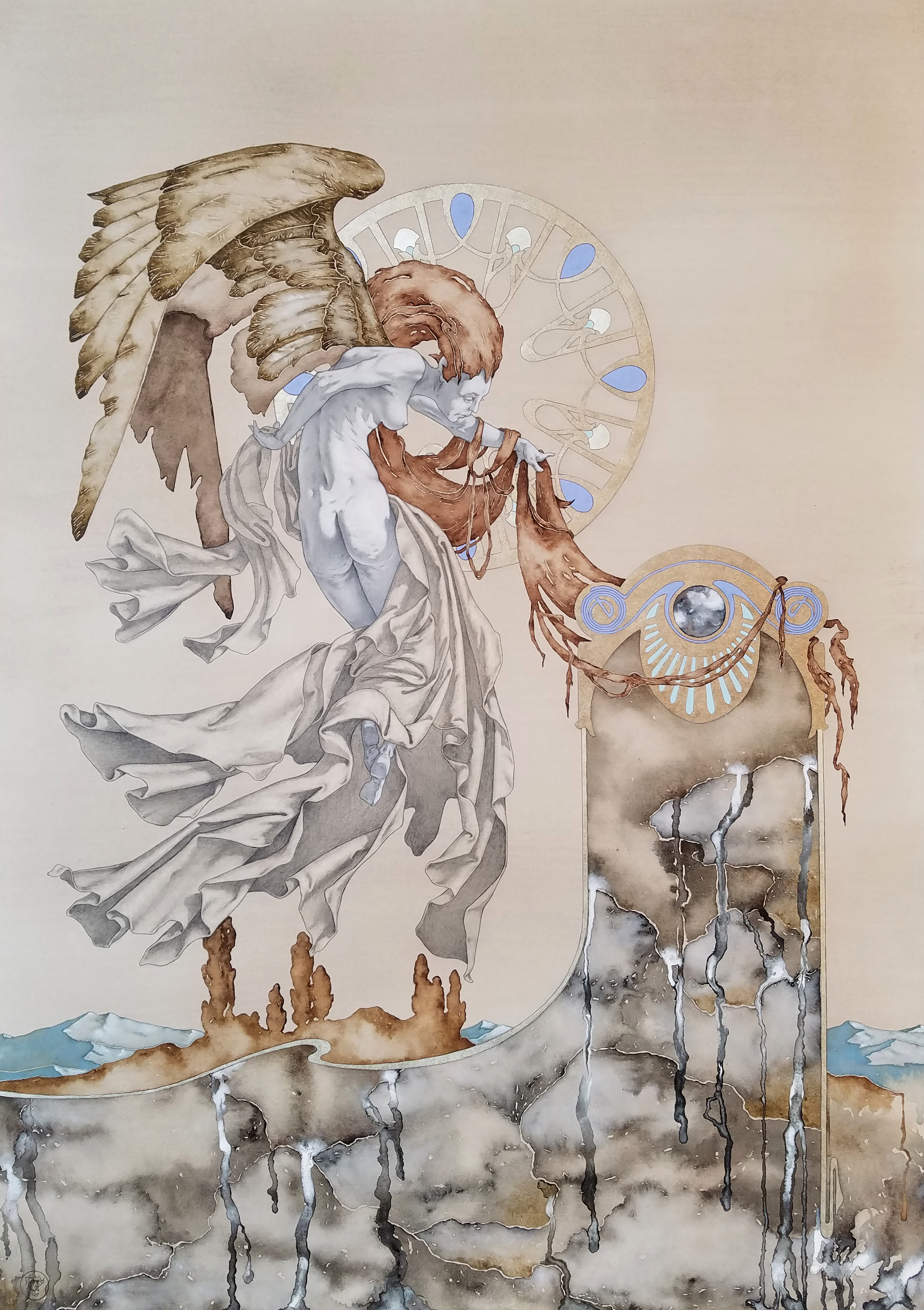
Elcinoe, The Aeloi Releasing Her Tears
Stumped conte, graphite, watercolor
22k Moon gold leaf & 12k White gold leaf on hand tinted Rives BFK paper
Here is a very brief account of Elcinoe's story. Elcinoe and Coellinyus were both minor Aeloi, technically Daemeads, who had charge over very specific parts of the Earth like a wood or meadow. They were in love. One day Coellinyus was captured by humans. He was tortured, abused, and exploited during his long captivity. Elcinoe wiped away his tears, sweat, and blood every night with her long hair. Upon his death she flew over the land of humans and wrung out her hair letting fall a rain of suffering and death. For this action she was awarded the epithet "lachrymortatrice" - she who cries tears of death - as well as elevating to the physical embodiment of a concept, that of consequence. She is not revenge, she actually represents the inevitable result of actions taken or ignored.
To capture the power of this concept I allowed myself to experiment a bit. Never one to abandon decorative elements I fused them to the symbolic aspects of the narrative. How? One way is containing the power of Elcinoe's sentence on the humans within a stylized framework. This achieves two things - it conveys a sense of metaphysical, intangibility to the act as well as suggesting that it is completely within her power to control and or change. That is important - consequence need not always be negative and it need not be repeatable. It is possible, (listen up humans!), to learn from history and do better. Another way is that Elcinoe is a powerful, physical presence and her hair an extension, strong and sweeping, of that presence. Last but not least, I chose to emphasize the duality of my conception by sectioning off the tumultuous deluge of Elcinoe's action from the landscape, barely visible in the form of silhouetted trees and far off mountains, as if the land had been obliterated. And, within that tumult I allowed my watercolor to drip down the piece in accord with the Aeloi's judgment and as a striking contrast to the elegance of other passages in the work.

Nayabella Exultatis
Stumped conte, watercolor
23.6k Versailles gold leaf on hand tinted Rives BFK paper
Nayabella Exultatis was chosen for the poster and promotional material for my 2016 Exhibition at Justus Fine Art Gallery titled Cantos From The New Pantheon with good reason. As a work of art she is perfectly representative of some of the aesthetic concepts I have been pursuing and she is a seminal character and a perfect example of the demigods that constitute the "Pantheon" in my myth The Shael Ovalis.
Aesthetically Nayabella Exultatis, which means "Exalted Spring" or "Nayabella Triumphant", has the type of decorative, Nouveau leaning flourishes that I growingly employ to heighten the symbolic aspect of the work as well as creating a framework which can present the nuance, power, and subtlety of figure and form to an incredible degree. The color assists in drawing the viewer into the world and, hopefully, rouses the curiosity thus bringing them deeper and invested in the whole story. The perfectly frontal, symmetrical placement gives the composition a religious, formal feel that is then countermanded by the fecundity of hair, vine, leaf, and flower. I sometimes refer to her as a verdant Saint.
Notes on her character can be illuminated not only in her haughty visage, but in a comparison with another Nayabella - The 2009 Nayabella, The Aeloi of Spring. In both pieces we see the same formal, frontal face and the kind of self important cast of the head and neck. In the 2009 piece there is a bit more sadness as Nayabella reflects on the transitory nature of her three month rule on Earth. In the 2016 work she exults in the fertility of her domain as she proudly lifts her head and neck, figuratively and literally pulling the growing flora from the ground.

Domida, The Aeloi of Night and the Rew Mancea Tree
Stumped conte, graphite, watercolor
22k Moon gold leaf on hand tinted Rives BFK paper
As an artist you sometimes wish you could know everything that a viewer thinks about one of your works. Undoubtedly this could be a good revelation or, possibly, a truly terrifying one. Among the many thoughts I would probe, while in the viewer's mind would be - how does this fit in with, or reflect on, other works in this artist's oeuvre?
What does this have to do with the work at hand you ask? Well, to me, Domida is quintessential Randall M. Good. It screams my style, choices, proclivities, and preoccupations from every line, color, and form. And, it is one of a long line of similar conceptions - and this, in my humble opinion, is one of the most successful.
If I broke it down I would note the simple, elegant and restrained composition, free from superfluous detail. The figure is a strong, highly modeled female, seen from behind and in a twisting pose that allows the light to play on the rounded forms of buttocks, breast, and thigh. Such heroic females have featured in countless of my works including Danae, Daphne, Semele, and, of course, other characters from my Shael Ovalis like Johannen and mighty Iyalishael. There is an interplay with nature, a oneness of human and some natural element, in this case a very spiritual and mystical tree. The devices of the halo, the silhouette against the moon, and Domida's mantle - that hangs like an Honor Cloth from one of my earlier Madonna's - serve to amplify the form's monumental, three dimensional qualities while at the same time pronouncing the formal two dimensional nature of the medium and presentation. Finally, with the decorative and symbolic line work, the piece is given a preciosity and decorative aspect in keeping with earlier works but whose character is specific to the aesthetic preoccupations of my concurrent efforts.
A brief note on Domida. In my book The Shael Ovalis, Domida is the Aeloi of night and as such one of her chief responsibilities is the regular occurrence and consistent functioning of that time of day. And the Rew Mancea Tree? Well, some things should be a mystery and invite the viewer to join the imaginary world of Aeloi and the New Pantheon of demigods.

Gaigophrates, The Aeloi of the Earth
Warm stumped conte, graphite, watercolor
23k Red gold leaf & 16k Light Green gold leaf on Rives BFK hand tinted paper
Gaigophrates as a written character is relatively easy to define. He is an elemental Aeloi. He is the steward of the Earth. He is not "The Earth" but he is of it and in many ways synonymous with it. He is in charge of making sure it is healthy and he regulates the world's processes. Realizing him visually was a bit more difficult.
To achieve this visualization I abandoned old concepts of earth as weighty, old, and ponderous. I think of him as vital and engaged. But I also think of him as the support, the ground, the base on which living things exist and thrive and grow. He is graceful yet firm. Strong and nurturing, but unyielding and unforgiving.
Thus I present him as a natural king. Not ostentatious, but with a swath of green drapery about him and spread over his domain, recalling the grassy carpets of the Earth. From his head, like a simple crown, grow branches, for he is the place in which roots take hold. There are mountains in the background - they too are his domain. Plants grow under his gaze - he gives nourishment to all. The palette is earthy, with colors redolent of clay, grass, stone and sand. And about his head is his glorious halo. As an elemental Aeloi, his metallic corona has stylized symbols of his charge. At all times it must be remembered that the Earth is the heart of Daeos so I merged that fact with other Earth elements and came up with a center motif that calls to mind both a heart, a tree, stone and cloud. Then I encircled it with bright red roots and trees because that system helps carry the life force of the world.
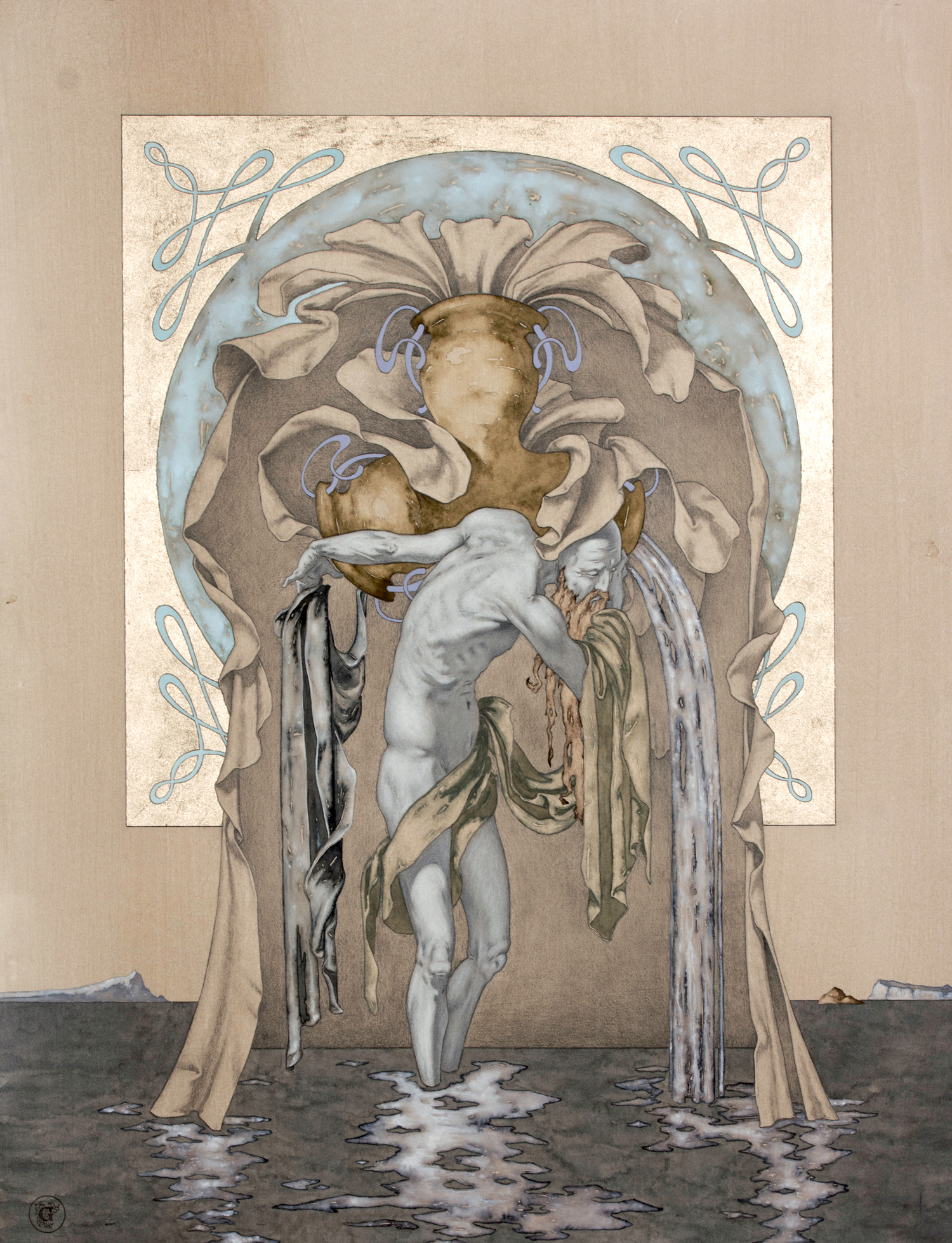
Typontus, The Aeloi of the Waters Dividing River, Lake, and Sea
Stumped conte, graphite, watercolor
22k Moon gold leaf on hand tinted Rives BFK paper
It happens occasionally that the main idea of a composition is solid, that it is almost perfect but it lacks one thing or one little refinement. Such was the case with Typontus. I knew from the outset that I wanted a figure very much in the tradition of other water deities - Poseidon/Neptune, Greek and Roman river Gods etc. - hence the older man with long flowing beard. Then I combined that with a powerful figure in my personal mannerist style of musculature and elongation matched to a serpentine, twisting pose. Furthermore, as an elemental Aeloi he would be graced by a beautiful, squared halo, with undulating lines like ripples in the water that served to highlight the monumental aspect of the composition as well as the symbolic/mystical function of separating the waters. The color scheme would, of course, echo the blues and greens of the Earth's waters. The difficulty was in the vessel he held. From the beginning I had imagined a single urn that he held on his shoulder and divided as he poured out the contents. After really thinking about the story of Typontus and embracing the tripartite aspect of his nature that I put in the three piece urn. It stabilized the composition and elevated the decorative and formal aspects. And, as an unexpected and pleasant surprise it gave more structure to the figure's pose.
When it all came together I was thrilled and Typontus quickly became one of my favorites. I feel like the piece pays homage to a powerful Aeloi, responsible for the life blood of the Earth and necessity of all living creatures: water.

Ijux, The Aeloi of Lighting, Storm, and Thunder
Stumped conte, graphite, watercolor
23k Red gold leaf on hand tinted Rives BFK paper
Ok, I will admit that I really love this piece. It is a powerful composition for a character with an incredibly powerful story. Sometimes things come together seamlessly when one is working on a project - this piece just had that feel.
The back story for Ijux (pronounced eye-yoos) is full of angst and drama. Out of boredom, a need for intimacy, and a bit of spite, Shelum, the goddess of light and energy lay with Gejeux, the Aeloi that embodied the air and winds. Knowing Shelum was with child, the pair, fearing the wrath of chief God Aetor, decided to hide the unformed child in the Earth. Gaigophrates, steward of the Earth, himself got nervous and allowed Typontus to flood the Earth, taking the fetus out to sea and hopefully to drown. Unformed as a being, but still comprised of parts both God and Aeloian, Ijux rose from the sea, wrathful and charged with the energy from his mother, winds from his father and pouring out torrential rain from his last watery home. He scourges the land and sea of this world as he cries out, in the form of thunder, rain, lightning, and wind in response to his abandonment and neglect and confusion. Indeed, in The Shael Ovalis one of his epithets is "The Aenoxymanos", meaning "one feared by God and Man".
I tried to create a composition that could match the drama of his story. For that effect I established a strong vertical triangle that has the feeling of soaring to the graceful, powerful form of Ijux, and at the same time has a weighty, downward thrust and push outward. It is energetic and stable. Ijux has been formed by his beginnings, but in no way crushed - he seems to embrace his outcast origins and grow more noble for it. The palette was chosen for its evocation of storm as well as old bruises on battered flesh. And, it is not by accident that the wound cloth that binds Ijux to the Earth is reminiscent of tornadoes and wind, and the broiling clouds are held within his mantle are touched with vivid white like flashing lightning.
It may be pleasing to some to know that Claeos eventually bestowed upon Ijux a lovely halo. This gesture was an acknowledgement not only of the destructive, regenerative, and purifying effects of his power but also a very real recognition of the power of individual determination and fortitude to survive and define oneself on one's own terms.
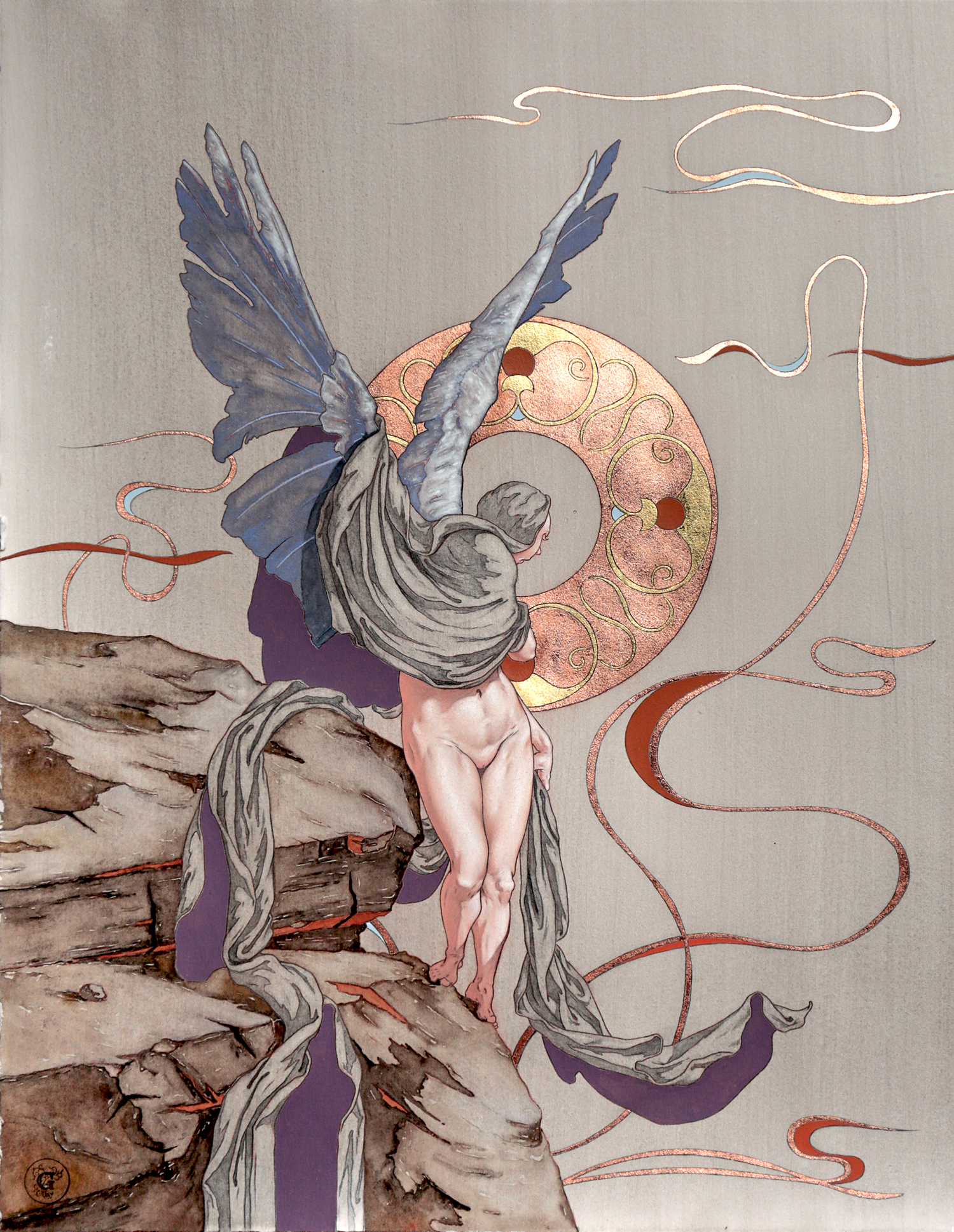
The Attendant to the Aeloi of Dusk
Stumped conte, graphite, watercolor
22k Orange gold leaf & Copper leaf on hand tinted Rives BFK paper
Many of the characters and concepts in the artwork and writing of The Shael Ovalis are pretty complex and heavy. It is fascinating and challenging. But sometimes it is nice to just let the imagination take a flight of fancy within the mythical world that I have been creating. This attendant Aeloi is the pleasant result of just such a flight.
In my story night and day are in the charge of two pretty powerful, elemental Aeloi - Liktos (Day) and Domida (Night). Liktos' perpetual, lustful chasing of Domida has been somewhat tempered by the intercession of Gaigophrates (Earth), but I began to reason the initial transition from day to night and vice versa could have been abrupt and frightening to early man. The Aeloi Persiphedaedos (Dusk) and Phaea (Dawn) serve the function of easing the transitions, softening them if you will.
So, my flight of fancy imagined this assistant to Persiphedaedos, as night rolls in preparing the way for Domida by draping her soft mantle over the earth. The gentle palette speaks to the subtle colors that the observant sees in the waning light of day. The attendant's halo, rather than being full gold is rendered in copper - warm, but much more like the sun seen just before it vanishes over the horizon, like an ember not a torch. Wispy, red accents hint at back lit clouds and the her cloth hangs over her face - an allusion to impending night and its veil of darkness.

Gejeux, The Aeloi of the Air and the Four Winds
Stumped conte, graphite, watercolor
23.75 Dream gold leaf on hand tinted Rives BFK paper
Before I talk about the aesthetics of this piece let's talk about anthropomorphism and how it is reflected in the writings and artwork derived from my Shael Ovalis. The characters, Aeloi or Macheum, God or Goddess, are often associated with an element or concept. Take for instance Ijux, the Aeloi of the Thunderstorm. He is not technically a thunderstorm, but that is inherent in his nature. He is an Aeloi, a demigod type creature who is so closely associated with thunderstorms that he is synonymous with them and even manifests as or produces them. The characters in my stories are sometimes created out of - or from - the very thing they represent. Sometimes they take it. Sometimes their actions earn it. What is always true is that these characters both manifest AND represent their specific, natural, conceptual, or elemental aspect. Concepts are given human characteristics. Humanlike characters take on symbolic qualities. It is a cosmic chicken and egg!
Such is the case with Gejeux, the personification and embodiment of the air and wind. Out of this dualistic nature, indeed because of it, I was able to create one of my finest figures. Gejeux is all conceptual mannerism. Conceiving his nature as air and wind as full of swirling, wispy, or powerful movement I gave his form an elongated, twisting aspect defined by a sensuous line. He is lithe and strong. His hips and torso twist like an eddy even while his arms are held back - either blown by a gale or holding open the cloth the keeps the winds in check or releases them at his whim. Gejeux's hair and ribbons, swept high and blown about from his forehead, add to the effect of swirling currents in the air. His giant square halo identifies him as an elemental Aeloi and conveys on him a true sense of nobility and power. While the winds can sometimes seem chaotic there is indeed a structure to their directions and power. Thus I constructed a vertical and horizontal grid out of visual elements (the mantles) that implies a sense of order. Then, within those parameters I allowed a swirling pattern to swirl and churn. The result is a remarkable marriage of the abstract and realistic working together to evoke a very powerful concept.
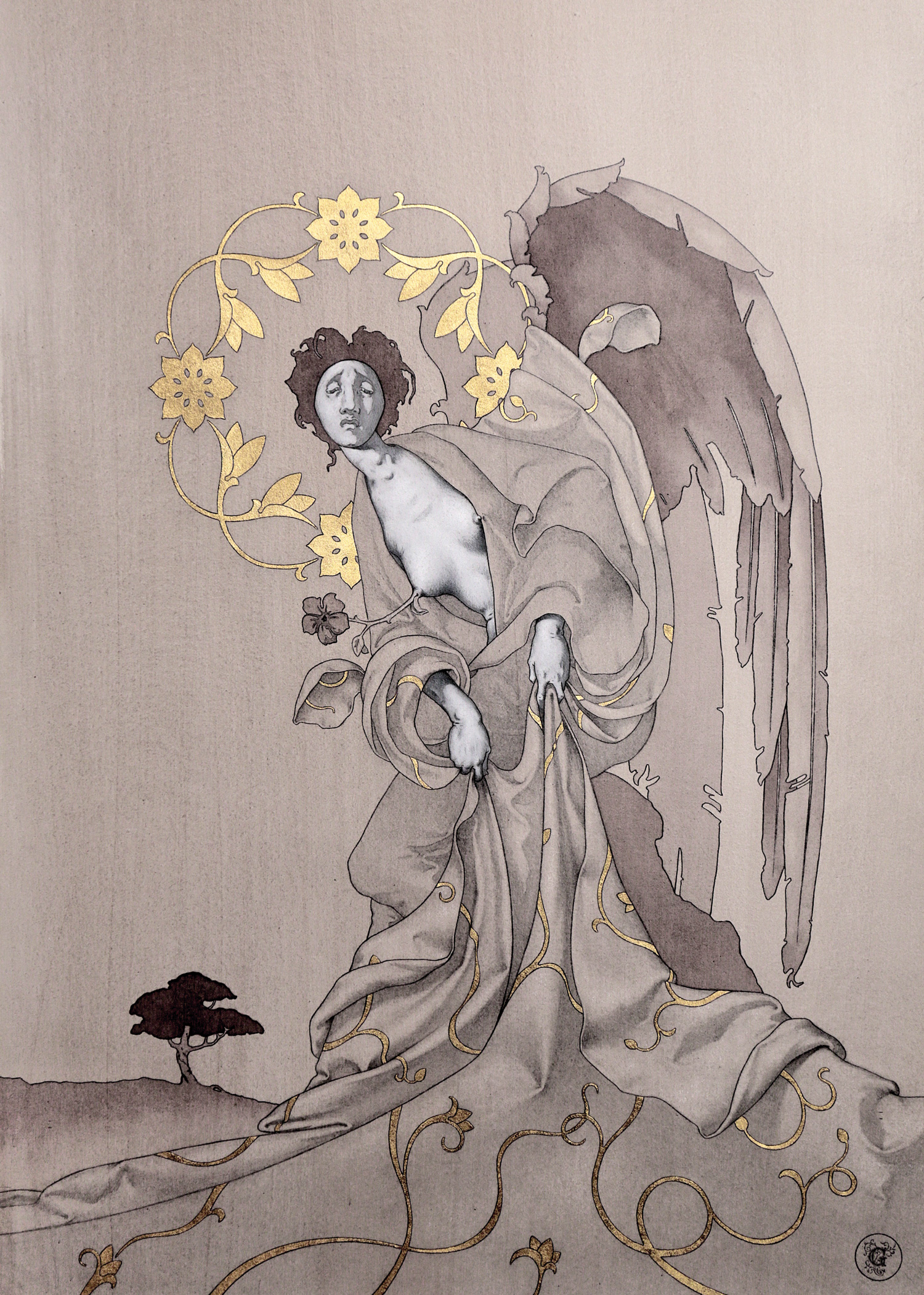
Nayabella, The Aeloi of Spring
Stumped conte, ink wash
23.75k Rosenoble gold leaf on hand tinted Rives BFK paper
With this work, completed in 2009, I have the opportunity to rewrite the artist notes after quite a bit of feedback from viewers. With that in mind I think I will address the most frequent question - Why does she look so sad?
Fortunately this is a good question and has real bearing on Nayabella's story and character as well as this, and subsequent portrayals of her. Nayabella is an Aeloi, a demigod-like being, and also one of the elemental stewards of the four seasons. Her special provenance is the Spring. As such she initiates and fosters growth and rebirth, especially amongst the plants, flowers and trees. In the composition this manifests as a show of fertility in the symbolic vines on her mantle, the leafy golden halo, and the flower that grows from her breast. She is given three months on the earth and she makes things grow and blossom and thrive during that time. For most creatures she is a welcome sight. So why the sadness? As a character within my myth The Shael Ovalis, Nayabella is a somewhat haughty, self important demigod. While the other seasons are quite happy and content with their three month allotment, she wants more. Knowing full well how revered she is, and welcome her yearly return, only exaggerates her narcissism. But that is just fine, it makes for a very compelling persona, regal in appearance and well worth portraying - again and again. Plus, like the little myth within the myth says - even when Nayabella pouts her tears fall on the earth as beneficial Spring rain - "Nayabella's pouting, shoots are sprouting, Nayabella's weeping, soon comes the reaping, Nayabella's sadness fills the earth with gladness."

Paetormanus, The Macheum That Tried To Extinguish the Moon
Stumped conte, graphite, watercolor, ink wash
23.75k Rosenoble gold leaf & 12k White gold leaf on hand tinted Rives BFK paper
This particular piece may be a little more difficult for some viewers to embrace because it seems like from the title he is a bad guy. Well, he kind of is - he was made to fight battles for a pretty vindictive creator. He tried to extinguish the Moon thereby blinding Claeos and making for an easier assault on Earth. He did not succeed, and in the attempt he lost his life as well as giving us one of the great stories in The Shael Ovalis: how Peacocks saved the world and earned the eyes on their tails. The battle also provided a showcase for the heroine of the myth - Iyalishael. Readers and supporters of my work are probably already familiar with the story of the Peacocks from some of my lectures or readings so I won't go into great detail. Suffice it to say that during the battle between Iyalishael and Paetormanus pieces of the Moon, which is actually the eye of the great goddess Claeos, were dislodged and fell with dangerous potential toward the earth. Perceiving the danger the Peacocks of earth flew up and caught the debris on their tails before any damage was done. As a reward Claeos gave to the birds her symbolic eye as well as the gift of prophecy. This story is alluded to in the stylized feathers that decorate the bottom of the piece. Indeed the whole piece is a fantastic symbol of the entire episode from Paetormanus' voluminous cloak, his moon formed halo as well as the representative moon behind him. I have always loved the beauty of his figure, not to mention the twisted pose and the air of sadness on his face - in art and in writing his character is not at all sure of his place in the world.
So, a quick note in Paetormanus' defense. As a result of the battle his body parts are scattered across the Aeos (Universe). His disembodied head sees a great deal, laments the whole notion of war and ultimately becomes (through the works of Timonestes and Uvo Minos) a poetic voice for the grandeur and terrifying sublimity of existence. Later it is revealed that his name in the Ovalian vernacular means something like "what man may (reluctantly) learn".
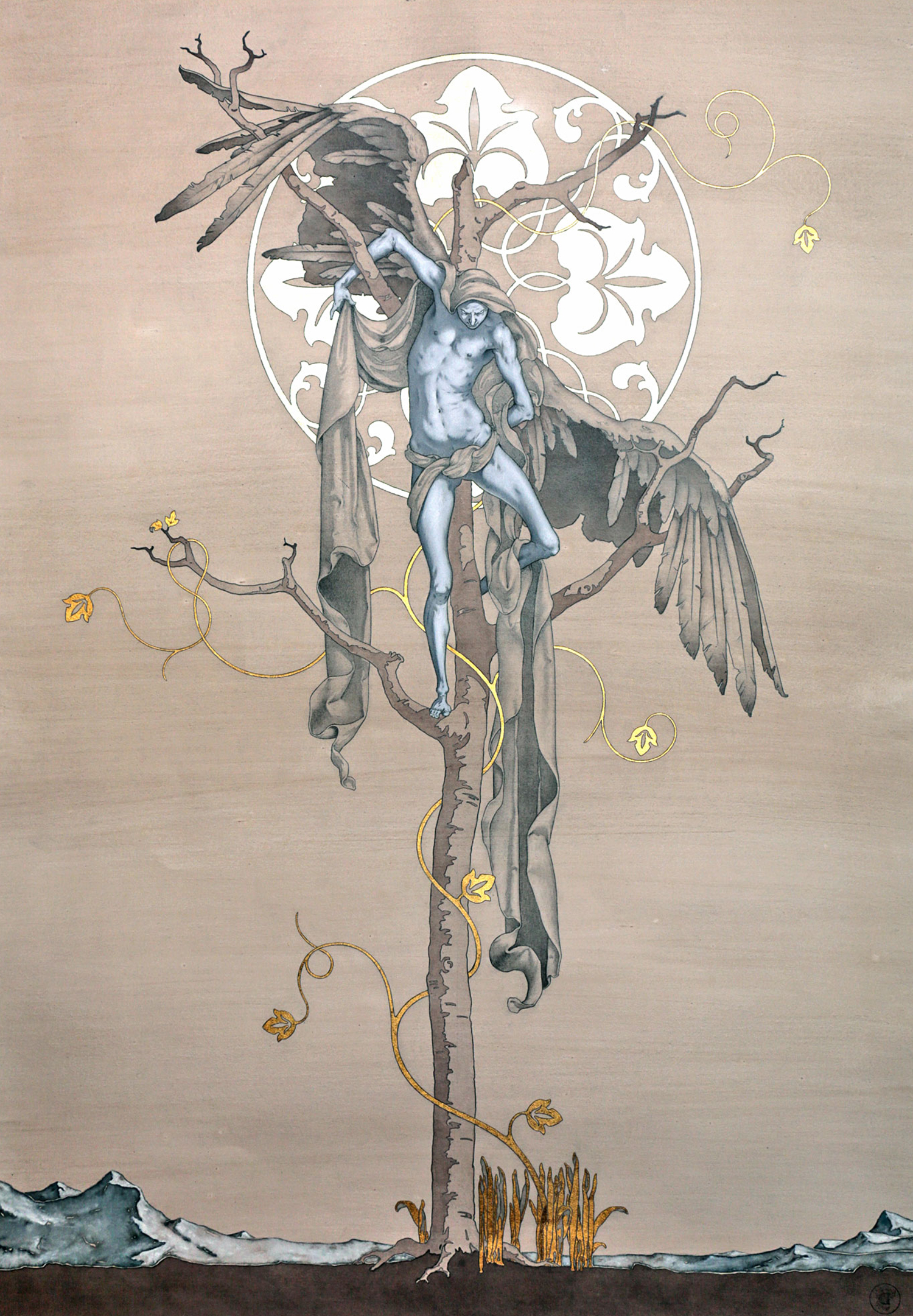
Aegostatius and the Last Tree on Earth
Stumped conte, graphite, watercolor
23k Red gold leaf & 16k Light Green gold leaf on hand tinted Rives BFK paper
It would be hard for me to over emphasize how important this piece is/was to my development as an artist, as well as its importance to clarifying my vision for The Shael Ovalis. With this work I was able to add an important element of pathos to the art and the story: a fundamental motif that would exist throughout the works - a fundamental honoring of the real and symbolic power of nature and at the same time a cautionary statement on mankind's tendency to abuse it.
All of the compositional elements work to that effect. The strong vertical creates drama, and it is no accident that it also calls to mind both the Crucifixion and Resurrection. Indeed, the Aeloi Aegostatius gives his life (by merging with the last living tree) to save not only that tree, but also the future generations of trees to come. The figure, which pays homage to a rarely seen drawing by Michelangelo and the famous Deposition painting by Rembrandt, is a prime example of my mannerist sensibilities used for explicate purpose - the Aeloi's attenuated body and wings seem to be already turning into the limbs and branches on which he hangs.
Furthermore, this is the first time that I added watercolor to what is in essence a drawing. That, combined with the gold leaf, two toned and of such a symbolic and decorative nature that it amplifies the works preciosity, giving the whole work an iconic feel. In my eyes it cries out like an altarpiece to the sublimity of nature and this piece affected the development of my visual art, my writing, and even my own personal philosophy.
Cantos from the New Pantheon
Cantos from the New Pantheon - Solo Exhibit Nov 2016
Justus Fine Art Gallery - Hot Springs, Arkansas
The Cantos from the New Pantheon is the latest exhibit of the ongoing series from the The Shael Ovalis project.
*Click on an image and then the round button in the lower right corner for more information and to switch between full and detail views of the image.











